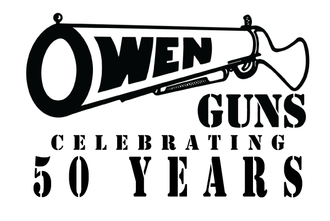
Vickers Medium Machine Gun
Welcome to Firearm Friday!, this week we are bringing you a piece of English and Australian history.

This is the Vickers .303 water cooled MMG medium machine gun!.

The Vickers machine gun or Vickers gun is a water-cooled .303 British (7.7 mm) machine gun produced by Vickers Limited, originally for the British Army. The gun was operated by a three-man crew one fired, one fed the ammunition, the other helped to carry the weapon. It was in service from before the First World War until the 1960s, with air-cooled versions of it on many Allied World War I fighter aircraft.

The weapon had a reputation for great solidity and reliability. In August 1916, during which the British 100th Company of the Machine Gun Corps fired their ten Vickers guns to deliver sustained fire for twelve hours. Using 100 barrels, they fired a million rounds without breakdowns. "It was this absolute foolproof reliability which endeared the Vickers to every British soldier who ever fired one. It never broke down; it just kept on firing and came back for more."

The Vickers machine gun was based on the successful Maxim gun. After purchasing the Maxim company outright in 1896, Vickers took the design of the Maxim gun and improved it, inverting the mechanism as well as reducing its weight by lightening and simplifying the action and using high strength alloys for certain components.

The British Army formally adopted the Vickers gun as its standard machine gun on 26 November 1912. There were shortages when the First World War began, and the British Expeditionary Force was still equipped with Maxims when sent to France in 1914. There was a total of 71,355 Vickers machine guns produced during the course of WW1.

When the Lewis Gun was adopted as a light machine gun and issued to infantry units, the Vickers guns were redefined as heavy machine guns, the tripod-mounted, rifle-caliber machine guns such as the Vickers were further re-classified as "medium machine guns".

During World War I, the Vickers gun became a standard weapon on British and French military aircraft, especially after 1916, initially in a single gun configuration it was later increased to a twin-gun standard in later war fighters.

The water-cooled Vickers Mark VI, Mark VI* and Mark VII were versions of the Mark I for use in tanks. They were introduced in 1936 and declared obsolete in 1944 (though they and the vehicles they were installed in were still in reserve use until the 1960s). They could be installed with either a left-hand or right-hand feed block.

The larger caliber (half-inch) version of the Vickers was used on armored fighting vehicles and naval vessels. Vickers, .5-inch, Mk. II was used in tanks, the earlier Mark I, having been the development model. This entered service in 1933 and was obsolete in 1944.

The Vickers, .5-inch, Mk. III was used as an anti-aircraft gun on British ships. This variation was typically four guns mounted on a 360° rotating housing. The belts were rolled into a spiral and placed in hoppers beside each gun. During the Second World War, the naval 12.7 mm version was also mounted on power-operated turrets in smaller watercraft, such as Motor Gun Boats and Motor Torpedo Boats.

The Mark IV and V guns were improvements on the Mark II. Intended for British light tanks, some were used during the war on mounts on trucks by the Long Range Desert Group in the North Africa Campaign.

The weight of the gun itself varied based on the gear attached, but was generally 11 to 14 kg with a 18 to 23 kg tripod. The ammunition boxes for the 250-round ammunition belts weighed 10.0 kg each. In addition, it required about 4.3 L of water in its evaporative cooling system to prevent overheating. The heat of the barrel boiled the water in the jacket surrounding it.

In British service, the Vickers gun fired the standard .303 inch cartridges used in the Lee–Enfield rifle, which generally had to be hand-loaded into the cloth ammunition belts.

The Vickers is a fully automatic belt-fed firearm which is fired from a closed bolt. When ready to fire, a round is in the chamber and the breechblock assembly and working parts are forward. It has a recoil operated, floating action with a toggle lock similar to a Luger pistol.

However, unlike the Luger, the mechanism is totally contained within the receiver or body of the Vickers. When operated, the floating action, which consists of the barrel, breechblock assembly and toggle mechanism, reciprocate as a unit within the body of the gun.

The mechanism is held together by recoiling plates, that connect the breech end of the barrel to the rear of the toggle mechanism. The breech is locked closed when the toggle is straight. The crank cocking handle is part of the floating action. It acts through the rear pivot of the toggle lock. Pulling the cocking handle causes the toggle to rise. This unlocks the breech and then draws the breechblock assembly rearward.

To fire the loaded gun, the gunner depresses a paddle at the rear of the gun. Through a lever, this pulls on a sliding bar that trips the trigger to release the firing pin. The weapon then cycles to load the next cartridge for firing. If the paddle is still depressed when the breech closes, the trigger is tripped again and a further firing cycle occurs.

We have a few Vickers in our museum and welcome you to come visit and see them in person.













